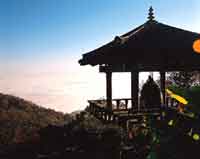...
Korean Buddhism
 Originally, Buddhism was introduced to Korea as a foreign thought system. It grew up in India and came to Korea through Central Asia and China, then it became an ideological foundation and cultural backdrop of Korean people and culture. Koreans added their own characteristics to the basic Buddhism they received, like usual development of Buddhist culture in other countries. Concerned with Taekwondo, the Korean Buddhisma is one of three important source in its philosophical foundation. You will be able to see the theoretical relation of Taekwondo and Korean Buddhism in "On Samjae & Kang-Yu" and "Philosophical Foundation of TKD Principles", though they are not complete yet.^^
Korean Buddhism Welcome! While you are in Korea, you will find that wherever you go there are Buddhist temples. They are dotted all over the cities, near the towns and villages and every mountain seems to have its share. Temples are living history and art. Today, temples are the places that Buddhists go to practice their religion, as well as home to the ordained members. One of the most important recognitions of the richness of the Korean culture is inclusion on UNESCO's prestigious World Heritage List. In 1995, the Chongmyo Shrine, Sokkuram Grotto and Pulguksa Temple, and the Haeinsa Temple Changgyong P'ango, the Depositories for the Tripitaka Koreana Woodblocks, were chosen - the last two are Buddhist. Buddhism was first introduced to the Korean peninsula in 372 CE. At that time, the peninsula was divided into three separate kingdoms: Koguryo, Paekche and Shilla. Korean Buddhism consists of many different sects. Chogye, a Zen order, is the largest in Korea. You can find Esoteric Buddhism, T'aego, Ch'ont'ae, Chinkak, Pure Land and many more which together create the colorful array of Korean Buddhism. Although most of the information below pertains to the Korean Buddhist Chogye Order, all sects share the same basic philosophy and customs, only the emphasis varies. In every Buddhist temple you are a very welcome guest. In order to maintain the harmony and make you feel more comfortable, here are a few things that you can do: Please respect it when someone tells you not to go somewhere or not to do something. Please do not linger in the doorway of a building. Either take a quick look inside and leave or go straight in. Always enter by the side door. If you are a Buddhist, feel free to bow in your own way if you wish. Do sit down and feel the atmosphere. Never sit or bow directly in front of the statue. "Let us now walk through the door of compassion To a life of joy, free from all suffering, To a life of peace and freedom, and to a life where we take responsibility for ourselves.¡± Note : We have used BCE, Before Common Era, and CE, Common Era, to designate the traditional non-Buddhist BC and AD respectively. Relics are calcified remains which are found after cremation. They are considered to be proof of advanced spiritual attainment and are therefore much revered by Buddhists. In the text, the names of Buddhas (enlightened beings) and Bodhisattvas (beings who have given themselves to helping all sentient beings) are in Sanskrit, a form easily recognized by more people. Sakyamuni (Sokamuni-bul) is the Historical Buddha who lived in India over 2,500 years ago. Amitabha (Amita-bul) is the Buddha of Universal Light, the Buddha of the Western Paradise. Vairocana (Pirochana-bul) is the Buddha of Cosmic
Power. Maitreya (Miruk-bul) is the Future Buddha. Bhaisajya-guru (Yaksa-yorae-bul)
is the Medicine Buddha, the Healer of Universal Woes. Belief in the Medicine
Buddha was very popular during the Shilla Period and many statues and shrines
existed at that time. Avalokitesvara (Kwanseum-posal) is the Bodhisattva of
Perfect Compassion. Manjusri (Munsoo-posal) represents Perfect Wisdom. Ksitigarbha
(Chijang-posal) is the Bodhisattva who looks after the suffering.
(Licensed by Studybuh.buddhism.org)

Temples in Korea
Of course, there are really much more temples in Korean than displayed above. But since I couldn't find their English Hompages I list only them above. Sorry! |